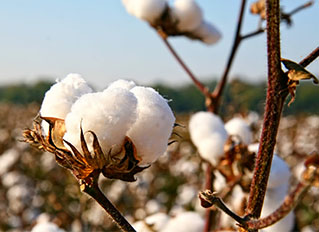
Cotton is a natural fibre obtained from the seed capsule, known as the boll of the cotton plant. About 25-30 days after the pollination the capsule fruit is ripe, bursts open and the white to brownish seed wool springs out. The stack lengths of the individual cotton varieties are between 2 and 5 cm depending on the country of origin, with the fibres from Egypt being the longest. Cotton fabrics are characterised by the following properties:
Cotton was already grown in India in the 3rd millennium BC. From India it arrived in China. But the Incas also used cotton at this time. In the 8th - 10th Century AD the Arabs brought the culture of cotton from Persia to North Africa, Sicily and southern Spain.
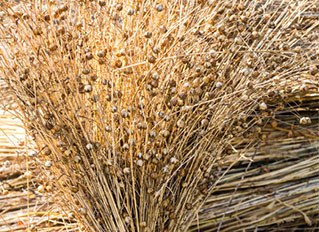
The linen fibre is extracted from the stems of the flax. The flat-plant, which also thrives in Europe, is not reaped once mature but is "plucked"; so that the stalks are not lost, as the linen fibre reaches to the roots. The flax fibre is obtained from the dried stems, which is subsequently spun into linen yarn. Linen is characterised by the following properties:
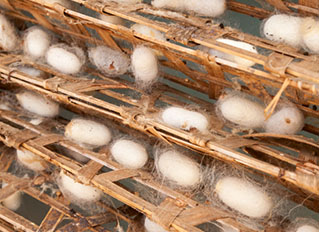
Silk represents for fibres that are obtained from cocoons of silk-spinning insects. The mulberry silk moths play the most important part. During pupation long, fine filaments are produced which consist of 75% fibroin and 25% seracin. To obtain the thread the cocoons are treated with hot steam to kill the pupae and then dipped into hot water and brushed. The threads of 3 to 8 cocoons are unreeled together. 300 - 800 m of reeled silk are produced. 10-11 kg of cocoons are required for 1 kg of raw silk.
The history of natural silk is to an extent the history of human vanity. China began producing silk 5000 years ago and kept it secret for 3000 years. It was not until 300 BC that the Arabs, Persians and Indians made their acquaintance with silk. The art of silkworm breeding and processing came to Como and Lyon around 1510.
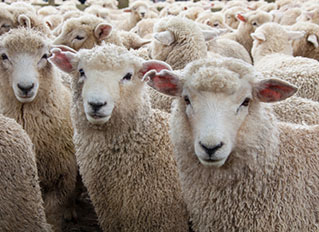
Wool is understood to mean fibres from woollen fleece. Sheep wool is distinguished by its high heat retention and high volume. Merino wool is very fine and is processed into elegant fabrics. Shetland wool on the other hand is a coarse wool and is suitable for sporty fabrics. Wool of the first fleece of a lamb after 6 months is called "lambswool". It is short particularly soft and very fine.
In the broader sense wool is a term for spinned animal hair e.g. from camels, angora and cashmere goats, angora rabbits
There are two types of woollen yarns:
Worsted yarns are relatively smooth, low in structure and, due to their stronger rotation, more robust.
Carded yarns are more voluminous, softer, but also not so strong and hard-wearing.
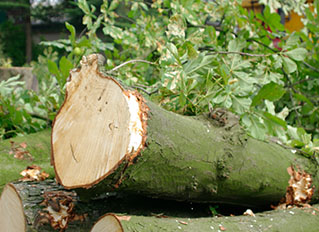
Although viscose is a chemical fibre it is comparable to cotton in its chemical composition. The raw material is pine and beech wood. The cellulose obtained from these is dissolved by means of a sodium hydroxide solution and pressed through fine spinning nozzles.
Viscose fibres are fine, soft and therefore extremely skin-friendly. They are predominantly used in glossy fabrics, but also most linings are made from viscose.

Fully synthetic fibres differ from all the raw materials described so far, that is they differ from the vegetable, animal and the chemically produced fibres on a cellulose basis, in that they consist of substances that are not found in nature. Raw materials are coal, crude oil, water and nitrogen.
The history of synthetic fibres is still very young. In 1922 the German Nobel Prize winner Prof. Hermann Stauchinger demonstrated that only artificially produced polymers (chain molecules) could be the starting products for chemical fibres. In 1950 the large-scale production of chemical fibres began in Germany.
In the fifties polyamide, polyester and polyacrylics became the "big three". With their different manifestations and modification properties they can be applied universally.
AB AC AG AL CA CC CF CL LF CLY CMD CO, BW CTA CUP CV EL FL GF GI HA HE HR HS HZ JU KE KP LA LI MAC MD | Manila Acetate Alginate Alfa Acetate Coconut Carbon fibre Polychloride Polyvinyl chloride Lyocell Modal Cotton (German: Baumwolle) Triacetate Cupro Viscose Elastane Fluorofibre Glass fibre Broom Hemp Henequen Cattle hair Horsehair Goat hair Jute Kenaf Kapok Latex Linen, flax Modacrylic Modal | MG MTF PA PAN, PC PB PE PES, PL PI PL PP PUR, PU PVC RA SE, S SI SN ST TA TV VI WG WK WL WM WN, WA WO, WV WP WS WU WY | Maguey Metal fibre Polyamide (Perlon®, Nylon®) Polyacrylic (nitrile) Polyurea Polyethylene Polyester Paper Polyethylene Polypropylene Polyurethane Polyvinyl chloride Ramie Silk (German: Seide) Sisal Sunn Tussah silk Triacetate Trivinyl Viscose Vicuna Camel hair Lama Mohair Angora Wool (German: Wolle) Alpaca Cashmere goats Guanako Yak |